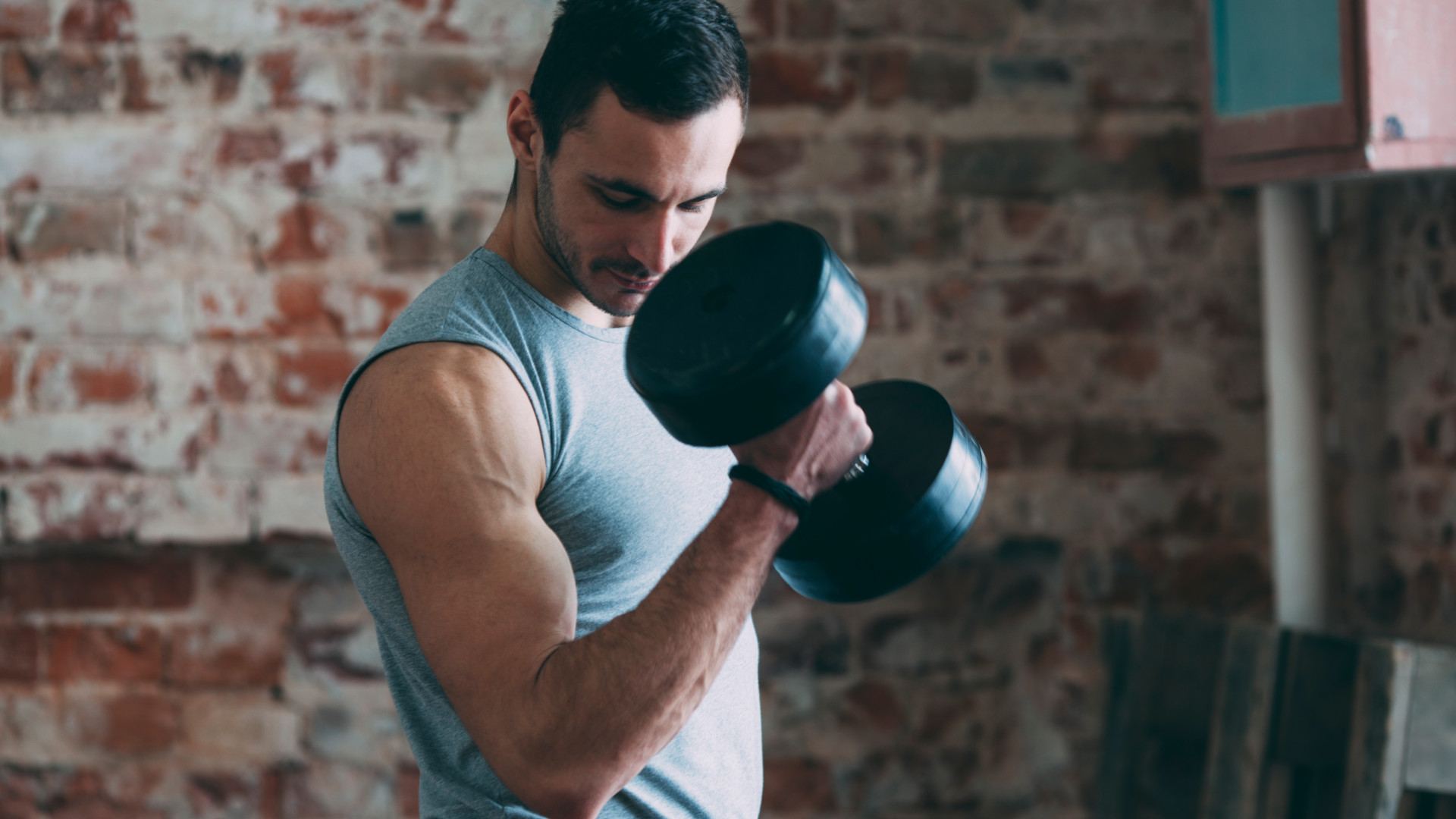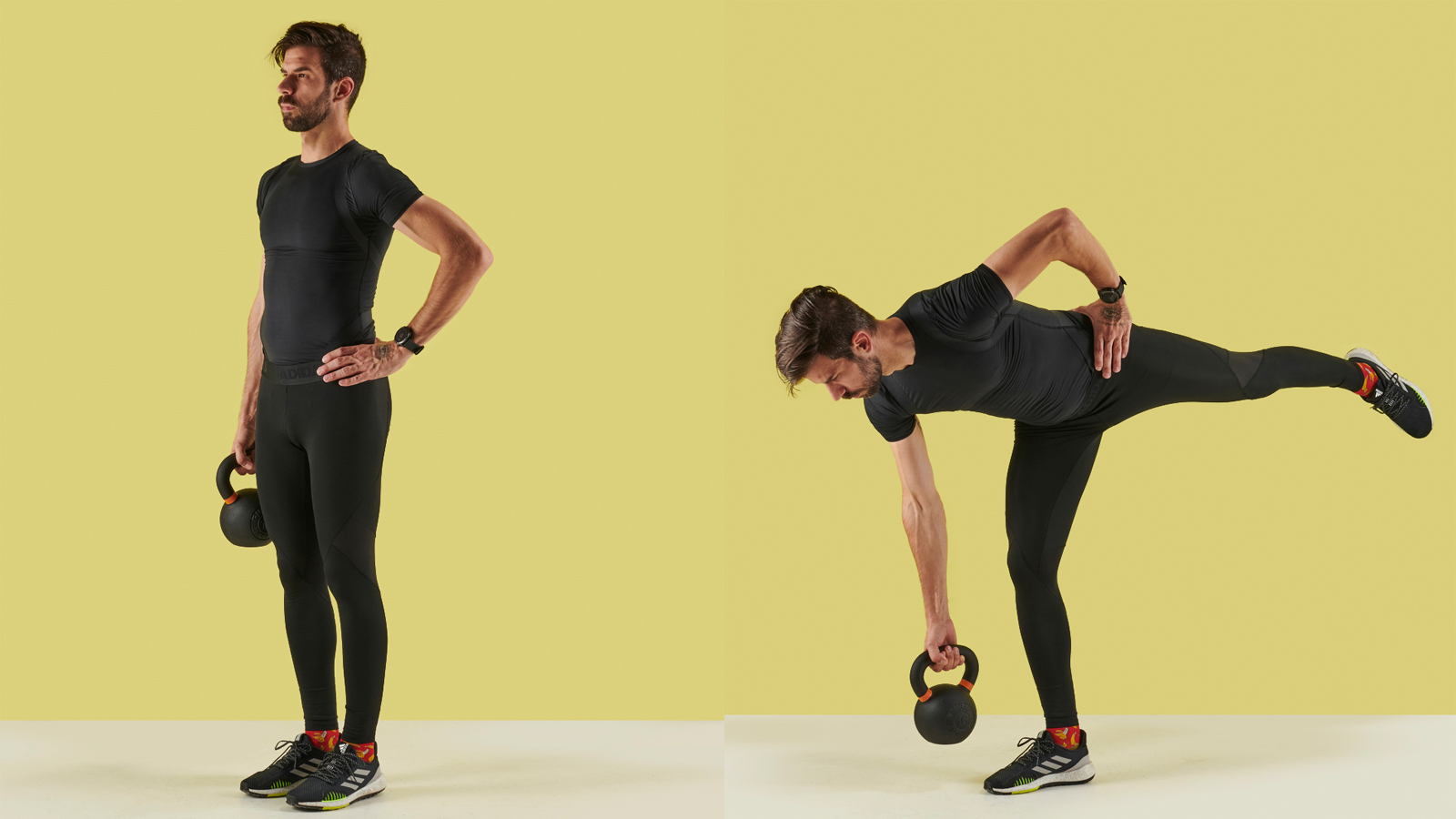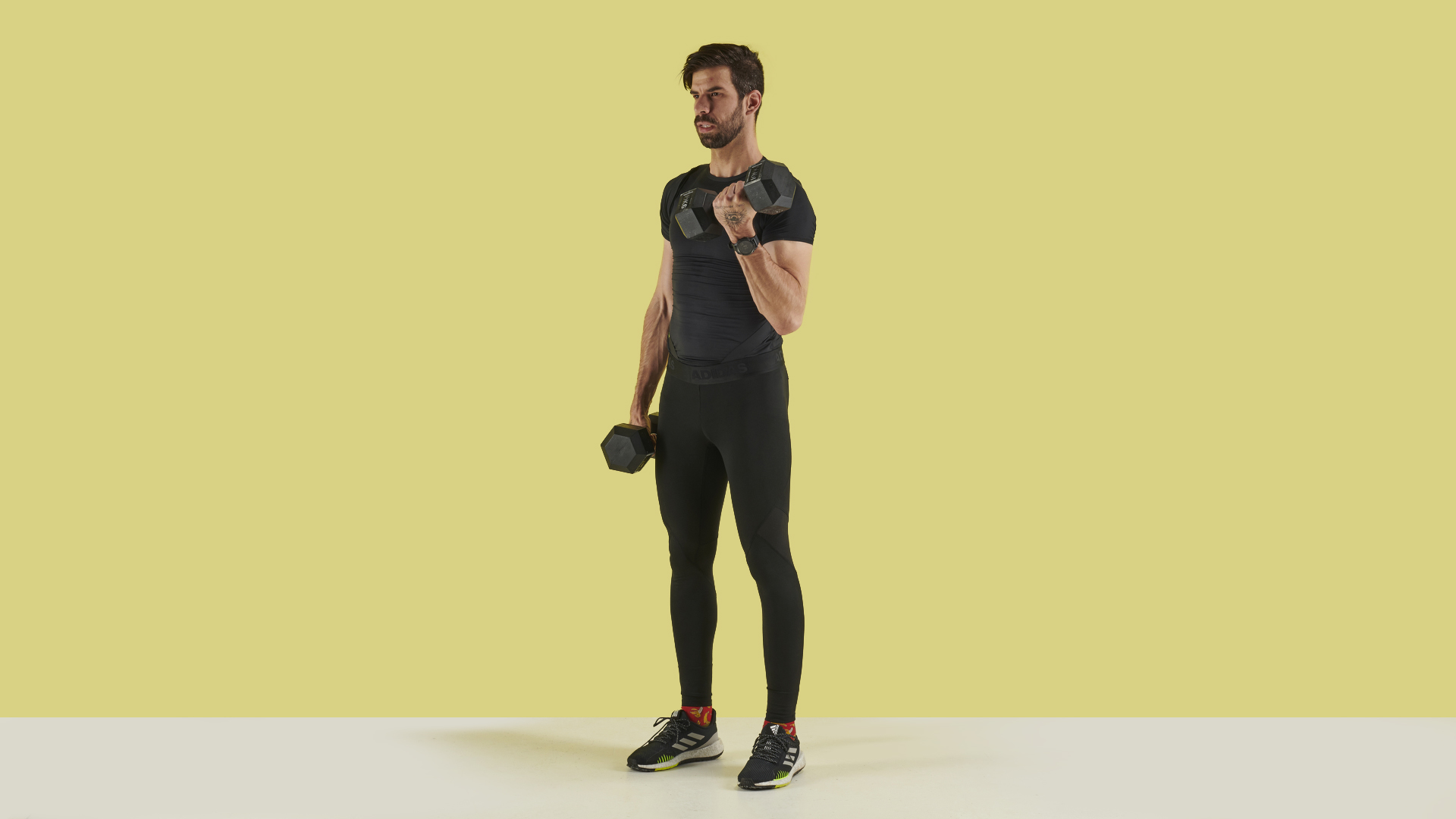

Here at T3 a pair of dumbbells is one of our favourite pieces of workout equipment. Whether you want to supercharge your strength, build lean muscle mass, lose fat or even up your aerobic fitness, you can do it all with the best home dumbbell exercises.
This is a workout that will give most of your muscles a run for their money, but one which beginners can do without injuring themselves. Please don't injure yourself. Even if you are new to workouts, you will be able to follow along this one, we chose exercises that can be performed at home, with only one (or a pair of) dumbbell(s). Although if you're new to pumpin' iron we do recommend you invest in the best gym gloves because, you know, chafing and a build up of callus is not nice.
Apart from dumbbells, you might need a weight bench to be able to do all the exercises listed below. Although, if you don't own one, then a sturdy surface or chair should do the trick. However, if you're doing any incline/decline exercises then it's probably best to get an adjustable weight bench.
Best home dumbbell workout for beginners
Before you begin your workout, make sure you're all warmed up and that your heart rate is in the right zone: roughly 50-55% of your max heart rate. Max heart rate can be calculated by subtracting your age from 220. For a reference, a 25 year old's max heart rate is 195. We also suggest grabbing your gym water bottle so you stay hydrated throughout this session.
You'll do this workout in a circuit, so one set of each exercise, as opposed to doing one exercise for multiple sets at a time. This will leave more time for your muscles to recover from the sets and you will feel fatigued later. Complete four rounds of the below circuit in total, with a 30-60 second rest between each exercise and a 60-90 second rest after you’ve completed one whole round.

Single leg deadlifts can be performed with kettlebells and dumbbells, too
1. Single leg deadlift
Muscles worked: hamstrings, thighs, glutes (bum muscle), core, lats, traps
Good for: improving balance and posture, toning bum, building thigh muscles
Get all the latest news, reviews, deals and buying guides on gorgeous tech, home and active products from the T3 experts
We love the deadlift here at T3, it’s one of the best compound exercises for building total body strength. Using an Olympic barbell is one of the best ways to perform this exercise and work almost all the muscles in your body. But, barbells are a bit fiddly to work out with at home, especially if you haven't got a garage gym at your disposal. Luckily, they can also be performed perfectly with a pair of dumbbells or even a single kettlebell, or in our case, dumbbells. Single leg deadlift also doubles up as core exercise, since you will need your core to be engaged as you balance your body.
How to: Stand with the dumbbell in one hand and the other hand placed on your waist. Bend forwards, keeping your back straight, whilst also keeping your arm – the one holding the dumbbell – straight, lowering it to the ground as you bend forward. Simultaneously, raise your extended leg behind you on the other side of your body. Stop when your back is parallel to the ground, then lift your back up to the starting position.
Tip: Try performing single leg deadlifts slower, this way you extend the period of muscle activation, burning more calories. Lower the weight/lifting the leg for three seconds, hold the midway point for one second, then back up in three seconds.

One arm dumbbell rows are a great alternative to bent-over barbell rows
2. One arm dumbbell row
Muscles worked: lats, biceps, shoulders
Good for: toning the arm, building solid back muscles
The one-arm dumbbell row is perfect for a home workout, since it can be performed using very little space, yet it works one of the biggest muscles in your body, the lats. As well as working your back, the one arm dumbbell row also works the biceps and the shoulders, toning the upper body area quite nicely. It is recommended to perform one-arm dumbbell rows on a weight bench, but it can also be performed on a chair or even just standing if you’re doing it at home.
How to: Performing the one-arm dumbbell row is not complicated: after you have placed yourself in the starting position (see above pic on the left), all you need to do is to pull the dumbbell up vertically, then release it back down to the starting position. Two key details to keep in mind: pull the weight towards your stomach and not your chest and also, don't drop your shoulders too far as you let the weight down. You should only move your arm, you don't twist your hip in order to drop the dumbbell lower.

Let's not forget about this classic dumbbell exercise
3. Standing dumbbell curl
Muscles worked: Biceps, core
Good for: toning the arms, building big arms (working with bigger weights)!
Bicep curls are one of those few exercises that don't need much introduction, as they’re one of the most popular exercises to get big arms. Although it’s an isolation exercise, we applied a little change to transform it into a sort-of compound one, by making you stand. When you perform standing dumbbell curls, you need to engage your core to keep your body from swaying back and forth as you curl the dumbbell.
How to: The movement is a familiar one, too: hold the weight in your hand with your arm extended, then bend the arm from the elbow, lifting the weight up. Finally, let the weight down, following the same motion how you lifted it up in the first place. Make sure to only bend your forearm as you pull the dumbbell up and focus on flexing the biceps. Our body naturally tries to help out the main muscle group activated by the exercise by involving any other muscles that can help the main one, in order to avoid muscle fatigue.

Bomb your shoulders with this deceivingly easy looking exercise
4. Dumbbell side lateral raise
Muscles worked: shoulders (mainly the side, the biggest portion), traps, core
Good for: building shoulder definition
Although the standing dumbbell lateral raise looks easy, but they are harder to perform correctly than how they look. We emphasise ‘correctly’, because a lot of people ‘half rep’ lateral raises, when you don't do the full range of motion during an exercise. What you want is a ‘clean rep’, when you perform the exercise correctly, from beginning to end. It’s very easy to half rep side lateral raises, especially if you are working in higher rep-ranges. Try doing four sets of 12 reps of dumbbell side lateral raises and you can quickly gauge how strong your shoulders are.
How to: Holding a dumbbell in each hand by your side and with your feet hip width apart, raise your extended arms to the side, up until shoulder height. Hold for a second, then lower the dumbbells back down to your sides. It's okay to bend your elbows slightly, but what's not okay is not raising your arms all the way to shoulder height. If you find yourself struggling by the end of the sets, it's best to drop the amount of weight slightly.

Ditch the barbell and work your chest with dumbbells
5. Dumbbell bench press
Muscles worked: chest, triceps, shoulders, forearms, traps
Good for: building a strong chest and getting big arms
The bench press is not exclusive to barbells, on the contrary. Dumbbells are equally as good to work your chest and your triceps. In case you haven't got a weight bench, you can do floor presses, when you lay down on the floor and do what you would otherwise do on a weight bench doing bench presses. Floor press puts less pressure on the shoulders, too.
How to: When doing bench presses, try to keep your elbows tucked in slightly and move your arms in a similar fashion as you would if you were to perform a barbell bench press. The dumbbells should move up and down in a vertical motion, not in a semi-circle, bumping the dumbbells to each other on the top.
Want to build muscle? Get your diet right
Whether your goal is to build lean muscle mass, supercharge your strength or lose fat, a healthy diet is just as important as exercising. Not to mention leaving enough time to rest.
A word that comes up almost all the time when talking about fitness is protein. Protein is one of the three macronutrients your body needs to function properly, the other two being fat and carbohydrate. General rule of thumb is to cover most of your energy needs with good carbs like vegetables, lean meat/fish and fruits, add moderate amount protein from a variety of sources to the mix and keep fat levels at bay. Fat needs should mainly be covered by eating good fats, like avocado, oily fish, nuts, coconut oil and so on.
Of the three macronutrients, we can store two in our bodies – carbs and fats – but we can't store protein, so you will need to supply your body with protein throughout the day to aid muscle growth and recovery. The most convenient way to take in protein is to to have a couple protein shakes a day, which is a combination of protein powder and water (or milk/milk substitute). Protein, of course, can and should be sourced from a variety of sources, like fish, nuts, lean meat, vegetables and more. Overworking and under-supplying your body of key nutrients is the best way to get injured and to lose motivation fast.
If you are doing moderate exercising, you won't need loads of protein either: shoot for 1.2-1.5 grams per body kilogram per day. Assuming you are around 80-90 kilos, you won't need more than 100-135 grams of protein to cover your daily needs. One scoop of protein powder usually has 26-28 grams of protein in it, while protein snacks usually have the same, add a high-protein/low-sugar yogurt and two medium size meals with some protein and you are all sorted for the day.
Make sure you also drink plenty of water, that will speed up your metabolism, protect your cells and help muscle regeneration, too.

Matt Kollat is a journalist and content creator who works for T3.com and its magazine counterpart as an Active Editor. His areas of expertise include wearables, drones, fitness equipment, nutrition and outdoor gear. He joined T3 in 2019. His byline appears in several publications, including Techradar and Fit&Well, and more. Matt also collaborated with other content creators (e.g. Garage Gym Reviews) and judged many awards, such as the European Specialist Sports Nutrition Alliance's ESSNawards. When he isn't working out, running or cycling, you'll find him roaming the countryside and trying out new podcasting and content creation equipment.